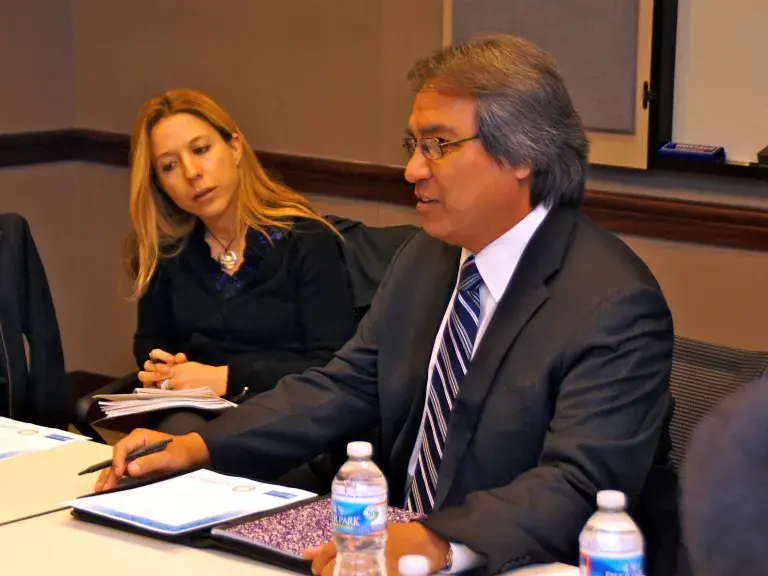

James Anaya, UN Special Rapporteur (third from left), listens to questions from the audience during a conference with held April 26-27 2012 at University of Arizona.
James Anaya, United Nations Special Rapporteur on the Rights of Indigenous Peoples (Special Rapporteur), recently conducted his first official mission to the United States to examine the situation of indigenous peoples. The Special Rapporteur traveled around the country April 23 through May 4, 2012, to gather information about the human rights concerns of indigenous peoples in the U.S. in light of the standards affirmed in the UN Declaration on the Rights of Indigenous Peoples. His itinerary included dialogues with tribal leaders, Native individuals, Native organizations, government officials, and others in Washington, D.C.; Tucson, Arizona; Anchorage and Dillingham, Alaska; Portland, Oregon; Rosebud, South Dakota; and Tulsa, Oklahoma.
The Special Rapporteur is an independent expert, appointed by the United Nations Human Rights Council, whose mandate is to address the concerns of indigenous peoples by examining, monitoring, and reporting on major issues regarding the human rights situations in particular countries. Since being appointed to the post in 2008, Mr. Anaya has issued 15 reports on the human rights of indigenous peoples in 15 countries. These country reports also make recommendations for law reform in order to improve conditions for indigenous peoples.
In addition to issues such as lands and resources, self-governance, and social and economic conditions, the Special Rapporteur invited discussion on the rights and special concerns of indigenous women and children related to implementation of the Declaration. Many Native women’s advocates and Indian leaders responded, testifying about violence against Native women and the need to restore safety to these women and strengthen the ability of Indian nations to address these crimes locally.
The Declaration, which is supported by the United States and reflects world consensus on the rights of indigenous peoples, is especially significant for Native women. It affirms the rights of Native women both as individuals and as members of indigenous communities, including rights to security of the person, gender equality, and access to justice. Article 2 of the Declaration reinforces nondiscrimination, declaring that indigenous peoples are “free and equal” to all others. Article 44 broadly recognizes the equal rights of Native women, including, but not limited to, rights to education and employment.
Article 22 explicitly calls for particular attention to be paid to the “rights and special needs” of indigenous women in the implementation of the Declaration. It directs countries to “take measures, in conjunction with indigenous peoples, to ensure that indigenous women and children enjoy the full protection . . . against all forms of violence and discrimination.”
Freedom from violence is one of the most basic human rights recognized under international law, but in the United States, violence against Native women has become a human rights crisis. The Indian Law Resource Center, NCAI Task Force on Violence Against Native Women, Clan Star, Inc., and National Indigenous Women’s Resource Center jointly submitted a paper[1] to inform the Special Rapporteur about the epidemic levels of violence against American Indian and Alaska Native women and girls in the U.S. The paper outlines how significant areas of U.S. law do not comport with standards of the Declaration, particularly those on protecting Native women and children from violence and ensuring nondiscrimination and equality under the law.
The United States has unilaterally limited the ability of Indian nations to protect Native women from violence and to provide them with meaningful remedies. The law places systemic jurisdictional restrictions on Indian nations, creating an unworkable, race-based system for administering justice in Native communities—a system that highlights this country’s continuing failure to meet the standards of the Declaration. The Supreme Court has stripped tribes of criminal jurisdiction over non-Indians. This has an especially harmful impact, as the overwhelming majority—some 88% of Native women survivors—identify their offenders as being non-Indian.[2] The Census Bureau also now reports that some 77% of all people living in American Indian areas (Indian reservations and/or off-reservation trust lands) and 68% of all people living in Alaska Native villages did not identify as American Indian or Alaska Native.[3]
The paper also emphasizes the dismal record of investigation, prosecution, and punishment of these crimes by federal and state governments, which allows criminals to act with impunity in Indian country, threatens Native women daily, and perpetuates a cycle of violence in Native communities. In sum, Native women who are subjected to violence are being treated differently and discriminated against in the United States just because they were assaulted on an Indian reservation.
While acknowledging that the United States has taken some important steps towards addressing violence against Native women, the paper calls for the United States to do much, much more to improve this crisis through measures, including:
1. Restoring the authority of Indian nations to prosecute non-Indians committing crimes in Indian country, particularly violent and sexual crimes against Native women, and clarifying that every tribe has full civil jurisdiction to issue and enforce protection orders involving all persons, Indian and non-Indian alike;[4]
2. Increasing federal technical, financial, and other support to Indian nations who wish to exercise restored crimination jurisdiction over non-Indians to enhance their response to violence against Native women, including support for tribes sharing concurrent state criminal jurisdiction under PL 280;
3. Bringing federal assault statutes into parity with state laws governing violence against women, especially with respect to severe acts of violence resulting in substantial bodily injury and involving strangling, suffocating, and assaulting a spouse, intimate partner, or dating partner;[5]
4. Fully funding and implementing the Tribal Law and Order Act, particularly in respect to the exercise of enhanced sentencing authority by Indian nations; the obligation of federal prosecutors to share information on declinations of Indian country cases; and the provision of training for and cooperation among tribal, state, and federal agencies;
5. Providing support and sufficient funding streams for culturally appropriate services designed by tribal providers, with input from tribal coalitions, for survivors of violence;
6. Creating a forum for dialogue, collaboration, and cooperation among tribal, federal, and state courts on the issue of violence against Native women on Indian lands and how the jurisdictional scheme under United States law unjustly discriminates against Native women contrary to the Declaration; and
7. Launching a national initiative, in consultation with Indian nations, to examine and implement reforms to increase the safety of Native women living within PL 280 states, including responses to requests by Indian nations for the United States to reassume federal criminal jurisdiction and for technical and financial support.
In his concluding remarks on May 4, 2012, Special Rapporteur Anaya stated:
“During my visit, I heard almost universal calls from indigenous nations and tribes across the country that the Government respect tribal sovereignty, that indigenous peoples’ ability to control their own affairs be strengthened, and that the many existing barriers to the effective exercise of self-determination be removed. It should be noted that the Violence Against Women Act, which is currently pending reauthorization before Congress, contains important provisions recognizing the jurisdiction of tribes to prosecute perpetrators of violence against Indian women and to hold them accountable for their crimes, which is a good step in the right direction to addressing this distressing problem.” After hearing from victims of domestic violence, Anaya stated that “once one sits down and directly hears these stories, it’s very powerful and it really does inform the way I look at this issue.”[6]
The Special Rapporteur will prepare a preliminary report of his assessment, which will be submitted to the United States for comments and consideration, and then issue a final report to UN Human Rights Council. Mr. Anaya’s report will include recommendations to the United States on how to address issues of concern to indigenous peoples, which should also include recommendations to the U.S. on ending violence against Native American women.
[1]The paper, titled “Self-Determination and Self-Government: Using the UN Declaration to End Violence Against Native Women,” is available at http://www.indianlaw.org/sites/default/files/public/UsingUNDeclaration-EndingViolenceAgainstNativeWomen.pdf.
[2]See Patricia Tjaden & Nancy Thoenne, U.S. Dep’t of Justice, Prevalence, Incidence, and Consequences of Violence Against Women: Findings From the National Violence Against Women Survey 9 and 22 (2000).
[3]2010 Census Briefs, The American Indian and Alaska Native Population: 2010, at 14 (January 2012).
[4]If enacted, bills pending in Congress such as S. 1925, the Violence Against Women Reauthorization Act, S. 1763, the SAVE Native Women Act, and H.R. 4154, the SAVE Act, could offer important life-saving steps in that direction by, among other things, restoring concurrent tribal criminal jurisdiction over non-Indian perpetrators of domestic violence, dating violence, and violations of protections orders that are committed in Indian country.
[5]Id.
[6]USET Headline News, “James Anaya: A Sit Down with the UN’s Man in Indian Country” (May 9, 2012).
